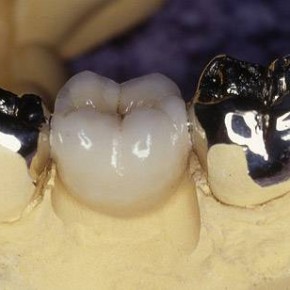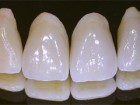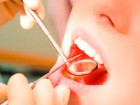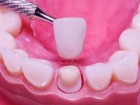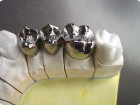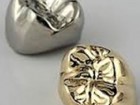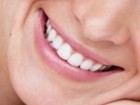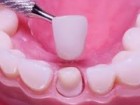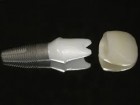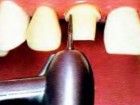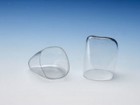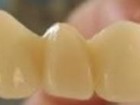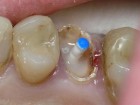Crowns
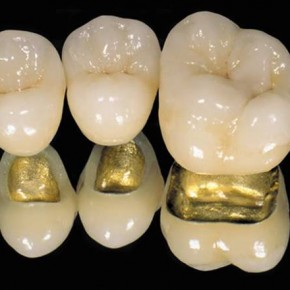 A tooth crown is a fixed structure that eliminates a tooth defect.The anatomical crown of a tooth can be destroyed.
A tooth crown is a fixed structure that eliminates a tooth defect.The anatomical crown of a tooth can be destroyed.
In such situations, tooth crowns are used to restore the shape, size of the tooth, give the tooth strength, as well as resistance to chewing loads.
They protect the teeth from further destruction.
Crowns for abutment can be used to install bridges.
Indications
- Restoration of the tooth crown with a strong destruction (more than 50%).
- Increased abrasion of hard fabrics.
- To restore a lost tooth.
- Defects of tooth crowns.
- Restoring the anatomical shape and functionality of the tooth.
- Fluorosis
- Anomalies of the teeth, manifested by the size or incorrect position of the teeth.
- Restore tooth aesthetics.
- An installed crown on a crooked tooth will help align it.
Contraindications
- Insufficient height of the preserved crown of the tooth.
- Tooth fracture.
- Allergy to dental crowns.
- Malocclusion.
- Periodontal disease.
- Thinning of the walls of the lower anterior teeth.
- Age to 16 years.
Pros and cons
Pros of dental crowns:
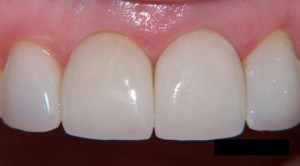
- Aesthetics.
- Durability and strength depend on the material and method of manufacturing the crown.
- Affordable for the price.
- Cast crowns do not require strong tooth grinding.
- White ceramic crowns Ideal for prosthetics of the front teeth.
- Ceramic crowns are biocompatible with tooth and gum tissues.
- An installed crown on a dead tooth extends its functionality.
Cons of dental crowns:
- Traumatization of healthy teeth, if they are used under supporting.
- Depilation under crowns on teeth can cause complications in the form of an inflammatory process.
- Ceramic tooth crowns are not strong enough.
- Unaesthetic crowns made of metal.
Materials for the manufacture
- Modern dentistry offers a wide variety of materials for the manufacture of dental crowns.
- For the manufacture of crowns using cermet, zirconium oxide, metal alloys, ceramics and other modern durable and hypoallergenic materials.
- In the manufacture of metal-ceramic crowns, cobalt - chromium and cobalt - nickel alloys are used, as well as alloys of precious metals: platinum, palladium, gold.
Types of Dental Crowns
The types of dental crowns are divided according to the material used:
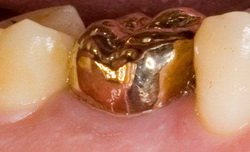
- Cermet tooth crowns. The inner part of the crown consists of a metal frame, which is lined with ceramic from the outside. As a result, the design is characterized by high strength and good aesthetic appearance.
- Dental structures made of non-metal ceramics. Such crowns are made entirely of ceramic. The absence of metal improves the aesthetics of dental crowns. Crowns can be made of porcelain or zirconia.Metal-free ceramic constructions are very durable, reliable in use and have a long service life.
- All-metal dental crowns. They can be solid, stamped, gold. Crowns on molars can be made of metal, because they still do not fall into the line of a smile. Under such crowns it is not necessary to sharpen a tooth strongly.
- Metal composite crowns are combined. They are made of cobalt - chrome alloy, and the outer surface is lined with plastic. Such crowns are also called metal-plastic.
- Dental crowns on implants.
Which tooth crown is better
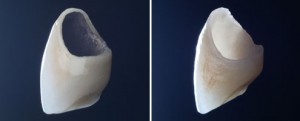
- When choosing the type of dental crown, it is necessary to proceed from the indications for the installation of the design, wishes and choice of the patient, as well as from his financial ability.
- Metal dental crowns are made of alloys of metals, precious metals, or only with their spraying. Cast metal crowns on the teeth restore the chewing function of the tooth. But according to external indicators, these crowns are the most unaesthetic.
- Ceramic-metal dental crowns are characterized by strength and naturalness. At the same time, this type of dental structures is inferior to ceramic crowns. On the plus side, cermet crowns can be placed on teeth with nerves not removed. The minus of the ceramic-metal construction is that with the smallest decrease in the gums, a gap is formed between the crown and the tooth and the metal rim of the dental crown becomes noticeable.
- All-ceramic dental crowns are the closest option to natural teeth. Differ in functional endurance. Ceramics from all the above materials is highly biocompatible.
How is it made
After preparing the teeth for prosthetics, the following is performed:
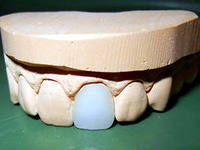
- Casting of both jaws. An impression is made so that it is possible to precisely make a crown taking into account both neighboring and antagonist teeth. For the manufacture of molds, a special impression mass is used.
- In the dental laboratory, a model of the teeth is cast from a cast, which is an exact copy of the patient’s teeth. On it, a sample of the future dental crown is modeled from wax.
- At the time of manufacture of permanent crowns are made temporary. They are fixed on the tooth using special cement, which allows them to be removed before installing permanent crowns.
- The metal frame of the crown is made, which, after trying and clarifying the color of the teeth, is covered with ceramics.
Installation steps
To install the structure, preparation of the tooth under the crown is supposed:
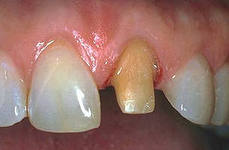
- Visual inspection of the tooth with a mandatory referral to an x-ray. If necessary, the required treatment and filling of the canals is carried out.
- To prepare the tooth for the installation of a crown on it under anesthesia, a tooth is prepared. Teeth grinding under the crowns is made taking into account the thickness of the walls of the structure. The walls of the prepared tooth should converge upwards so that a crown can be easily put on the tooth. At the same time, steps are made in the cervical region of the tooth.
- Depulpation teeth if necessary. Putting crowns on living teeth or dead, the specialist decides.
- If the upper part of the tooth is missing, then the doctor sets up a stump metal tab. It will contribute to reliable fixation of the crown on the tooth.
- If there is no anatomical tooth crown, a pin is placed in the tooth root.
- Taking casts, which the doctor then sends to the dental laboratory.
- Trying on the finished design. Color selection.
- Fixing the crown on the tooth using permanent or temporary cement (at the discretion of the doctor).
How is a dental crown different from a filling?
Dental crown and fillings are used to restore the shape and appearance of the tooth.
Their difference:
- Tooth filling occurs directly in the patient's oral cavity. The seal is attached to the walls of the tooth. She acts as a wedge. With pressure on the filling, it puts pressure on the walls of the tooth and can cause it to fracture. A large volume of fillings increases the likelihood of a tooth fracture.
- The tooth crown closes the tooth from above, so the tooth under the crown remains intact, even with strong pressure on it. The crown is made in the laboratory.
Video: “Restoration of a tooth crown with a filling”
The advantages of a dental crown:
- The material from which the crown is made is much stronger than the one from which the fillings are made.
- The crown breaks less often. If the crown has become cemented or broken, then dental crowns can be repaired or a tooth crown can be replaced. When filling, this option is not possible.
- The crown transfers pressure when chewing to the root. And the filling is on the remaining parts of the tooth, which can provoke a fracture.
For high-quality restoration of the tooth, one must be guided by the following rule:
To restore the tooth with a filling, the defect should be no more than 1/3 of the volume of the remaining tooth. If the defect is 1/2 - 1/3, then the restoration is carried out by a tab or veneer. With the destruction of the dental crown by more than 50% - the most effective way to restore the tooth - the crown.
Dental crown life
The service life of dental crowns depends on factors: on the material the crown is made of, the quality of the construction, the care of the prosthesis, and the condition of the gums.
- Metal crowns have a service life of 25 years or more.
- Cermet crowns - 10-12 years.
- Non-metal structures have less use - from 5 to 10 years.
Often the crown has to be removed, not because of wear, but because of problems with the tooth under the crown. The cause may be poor preparation of the tooth for prosthetics.
After a year and a half after prosthetics, when the guarantee for dental crowns ends, chronic inflammation in the area of the tooth root, which is characterized by swelling and soreness of the gums, often manifests an unpleasant smell from under the crown of the tooth.
The life of the crowns is affected by oral care.
Care
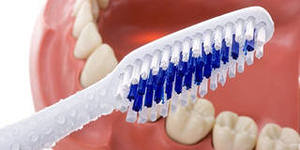
- The same as for real teeth. It is advisable to visit the dentist at least once every six months to check the condition of the structure and the surrounding tissues.
- If single crowns are installed in the mouth, then they can be cleaned with a toothbrush with paste and thread.
- If in the oral cavity - a bridge - irrigators are recommended for irrigation of the structure. Thus, food debris and soft plaque are removed from hard-to-reach places.
FAQ
- Question: The doctor suggests putting crowns on the teeth. Is it harmful to the tooth to turn?
Answer: Turning is a traumatic procedure for a tooth. It is a necessary step in the preparation of the tooth under the crown.
- Question: How much does a ceramic tooth crown cost?
Answer: The cost depends on how much and which metal will be used. Depending on this, such a crown will cost from 3 to 40 thousand rubles.
- Question: What does a crown look like on a tooth made of ceramic? Is it worth putting such a crown on chewing teeth?
Answer: The crown made of ceramics is no different from a real tooth. On chewing teeth, it is better to put a crown made of cermet or metal, because they are more durable.
- Question: How do dental crowns stick to a tooth?
Answer: For gluing crowns use dental cement or special glue for crowns.
- Question: Do teeth under the crown deteriorate?
Answer: If the preparation for the installation of the crown is carried out qualitatively, then the teeth under the crown cannot deteriorate. After all, the crown is put on the tooth in order to preserve it.
- Question: How to clean tooth crowns?
Answer: Crowns should be cleaned just like all other teeth with a toothbrush with toothpaste and floss.
- Question: Can there be any complications after installing the crown on the teeth?
Answer: If a high-quality preparation of the tooth was carried out before installing the crown, then there should be no complications.
Dental crown prices
The cost of a crown per tooth depends on the material and the method of its manufacture.
More expensive ceramic crowns are usually recommended for use only on the front teeth, therefore, in order to save money, you can put crowns on chewing teeth, which are cheaper, for example, from cermets.
| Type of crown | Price (in rubles) |
| Metal cast crown | 700 — 15000 |
| Cermet crown | 3000 — 40000 |
| Zirconium oxide crown | 16000 |
| Porcelain crown | 13000 |
| Metal-plastic crown | 4000 |
| Cermet implant crown | 10000 — 14000 |
| Ceramic crown made of zirconium on the implant | 25000 |
Photos before and after the installation of dental crowns
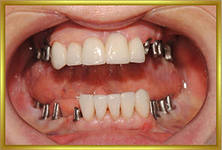 |
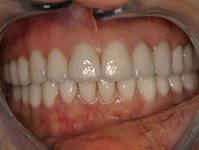 |
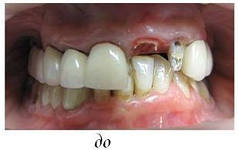 |
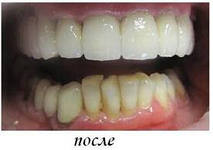 |
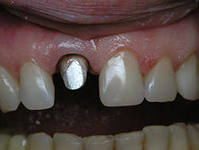 |
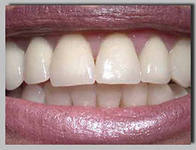 |

